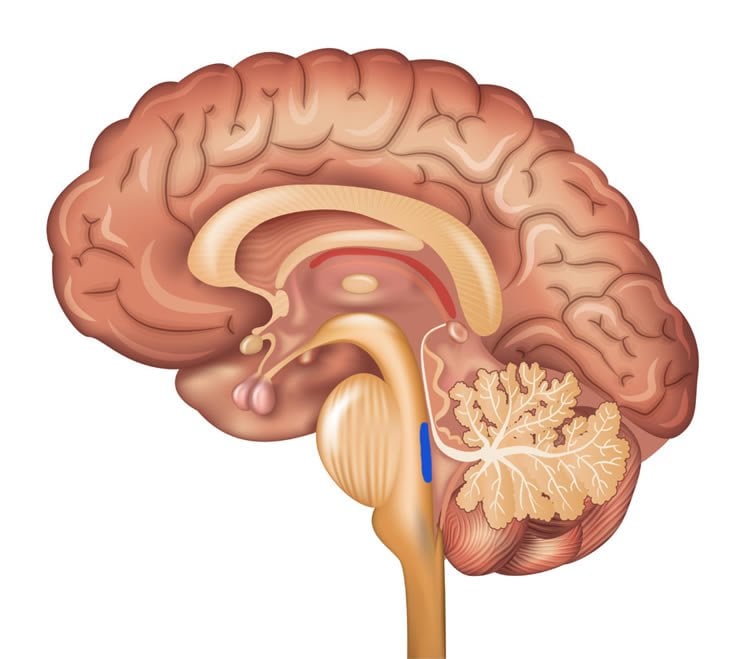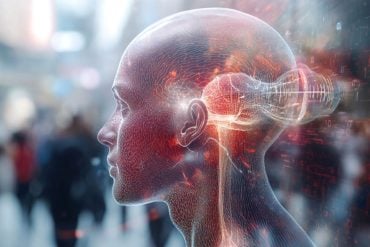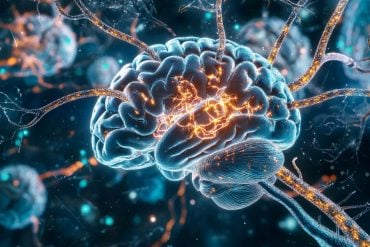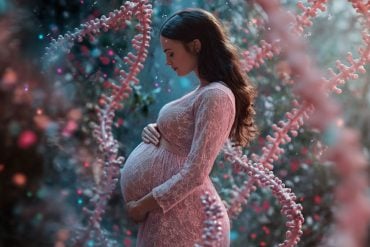Summary: Researchers implicate the locus coeruleus in storing memories of stressful events.
Source: USC.
A tiny part of the brain plays a big role in what we successfully remember during stressful or emotional situations, according to a new USC study.
Researchers at the USC Leonard Davis School of Gerontology found that the locus coeruleus, a small region in the brainstem, is helping to select and form what are known as “adaptive memories,” which are important for survival.
“This area in the brainstem is helping us catalog the memories of experiences that are exciting or traumatic,” said the senior author Mara Mather, a professor at the USC Leonard Davis School of Gerontology. “During these experiences, it is sorting which information is important to remember to help us avoid similar negative situations in the future.”
The locus coeruleus is highly connected to the rest of the brain. This small nucleus releases norepinephrine, a neurotransmitter and hormone responsible for regulating heart rate, attention, memory and cognition.
The memories that get preserved during arousing or frightening events may seem random. For instance, a witness to a robbery may recall what they were wearing that day but forget the perpetrator’s face.
“A surge in locus coeruleus activity during highly emotional or arousing events, such as a car crash or a scene of violence, helps to transform those experiences into vivid and lasting memories,” said David Clewett, the study’s lead author and a New York University postdoctoral fellow who completed a PhD in neuroscience at USC in 2016.
The study was published February 7 in the Journal of Neuroscience.
Brain scans, pupil dilation shed light on locus coeruleus activity
For the study, the researchers sought to uncover how processes in the brain govern which memories get preserved during highly emotional situations, especially when an individual is faced with a threat.
The researchers recorded arousal and locus coeruleus activity in 22 participants using both brain scans and the measurement of pupil dilation in participants’ eyes – an outwardly visible marker for emotional arousal and locus coeruleus activity.
While undergoing a functional MRI, participants were shown images of scenes with photos of objects superimposed over them. The participants’ task was to focus on and memorize each scene while ignoring the distracting objects.

On some trials, participants were given a punishment threat – a sharp buzzer sound signaling that they would lose money if they failed to accurately remember the appropriate scene image. Following the scans, subjects took a memory test to see if they remembered the relevant background images and the less important foreground images.
Goal-related memories strengthen under threat
The threat of losing money led to higher levels of activity in the locus coeruleus on fMRI scans as well as more pupil dilation on average at the time of scanning, indicating a higher level of emotional arousal when additional focus was needed. Subjects also showed better memory for the background images relevant to the monetary goal but worse recollection for the irrelevant foreground images, indicating that the threat-based emotional arousal led to the enhancement of important memories—and the suppression of memories not relevant to protecting against the threat.
Clewett said that this process would potentially enable individuals to draw upon strengthened memories to avoid unpleasant outcomes in the future.
Previous research by Mather, director of the USC Emotion and Cognition Laboratory, has highlighted the locus coeruleus and its roles in cognition and memory. Current research in the lab focuses on how locus coeruleus function changes in aging and Alzheimer’s disease. “Becoming more easily distracted by irrelevant information is one hallmark of aging and we are especially interested in how changes in the locus coeruleus might contribute to attention and memory changes in aging,” Mather said.
Funding: This project was funded by federal NIH grant R01AG025340 and was also funded by a USC Endowed Fellowship to Clewett. Coauthors included Ringo Huang and Rico Velasco of the USC Leonard Davis School and Tae-Ho Lee of the University of North Carolina.
Source: Beth Newcomb – USC
Publisher: Organized by NeuroscienceNews.com.
Image Source: NeuroscienceNews.com image is adapted from the USC news release.
Original Research: Abstract in Journal of Neuroscience.
doi:10.1523/JNEUROSCI.2097-17.2017
[cbtabs][cbtab title=”MLA”]USC “Tiny Brain Region Responsible for Strengthening Important Memories Under Stress.” NeuroscienceNews. NeuroscienceNews, 14 February 2018.
<https://neurosciencenews.com/stress-memory-locus-coeruleus-8488/>.[/cbtab][cbtab title=”APA”]USC (2018, February 14). Tiny Brain Region Responsible for Strengthening Important Memories Under Stress. NeuroscienceNews. Retrieved February 14, 2018 from https://neurosciencenews.com/stress-memory-locus-coeruleus-8488/[/cbtab][cbtab title=”Chicago”]USC “Tiny Brain Region Responsible for Strengthening Important Memories Under Stress.” https://neurosciencenews.com/stress-memory-locus-coeruleus-8488/ (accessed February 14, 2018).[/cbtab][/cbtabs]
Abstract
Locus Coeruleus Activity Strengthens Prioritized Memories Under Arousal
Recent models posit that bursts of locus ceruleus (LC) activity amplify neural gain such that limited attention and encoding resources focus even more on prioritized mental representations under arousal. Here, we tested this hypothesis in human males and females using fMRI, neuromelanin MRI, and pupil dilation, a biomarker of arousal and LC activity. During scanning, participants performed a monetary incentive encoding task in which threat of punishment motivated them to prioritize encoding of scene images over superimposed objects. Threat of punishment elicited arousal and selectively enhanced memory for goal-relevant scenes. Furthermore, trial-level pupil dilations predicted better scene memory under threat, but were not related to object memory outcomes. fMRI analyses revealed that greater threat-evoked pupil dilations were positively associated with greater scene encoding activity in LC and parahippocampal cortex, a region specialized to process scene information. Across participants, this pattern of LC engagement for goal-relevant encoding was correlated with neuromelanin signal intensity, providing the first evidence that LC structure relates to its activation pattern during cognitive processing. Threat also reduced dynamic functional connectivity between high-priority (parahippocampal place area) and lower-priority (lateral occipital cortex) category-selective visual cortex in ways that predicted increased memory selectivity. Together, these findings support the idea that, under arousal, LC activity selectively strengthens prioritized memory representations by modulating local and functional network-level patterns of information processing.
SIGNIFICANCE STATEMENT Adaptive behavior relies on the ability to select and store important information amid distraction. Prioritizing encoding of task-relevant inputs is especially critical in threatening or arousing situations, when forming these memories is essential for avoiding danger in the future. However, little is known about the arousal mechanisms that support such memory selectivity. Using fMRI, neuromelanin MRI, and pupil measures, we demonstrate that locus ceruleus (LC) activity amplifies neural gain such that limited encoding resources focus even more on prioritized mental representations under arousal. For the first time, we also show that LC structure relates to its involvement in threat-related encoding processes. These results shed new light on the brain mechanisms by which we process important information when it is most needed.






